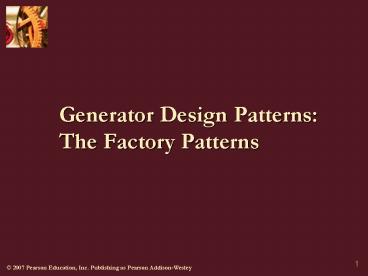Generator Design Patterns: The Factory Patterns - PowerPoint PPT Presentation
Title:
Generator Design Patterns: The Factory Patterns
Description:
Generator Design Patterns: The Factory Patterns Objectives To present the structure, behavior, and characteristics of generator patterns To discuss the uses of ... – PowerPoint PPT presentation
Number of Views:114
Avg rating:3.0/5.0
Title: Generator Design Patterns: The Factory Patterns
1
Generator Design Patterns The Factory Patterns
2
Objectives
- To present the structure, behavior, and
characteristics of generator patterns - To discuss the uses of factory methods
- To present the Factory Method and Abstract
Factory design patterns
3
Topics
- Instance creation
- Generator patterns
- Factory methods
- The Factory Method pattern
- The Abstract Factory pattern
4
Instance Creation
- There are two ways to create objects
- Instantiating a class using one of its
constructors - Cloning an existing object
- Clients may use another class to create an
instance on their behalf this is the essence of
the generator pattern category. - Analogy a tailor
5
Generator Pattern Structure
The Client must access the Generator that creates
an instance of the Product and provides it to the
Client
6
Broker Pattern Behavior
7
Generator Pattern Advantages
- Product Creation ControlA generator can mediate
access to constructors so that only a certain
number or type of product instances are created. - Product Configuration ControlA generator can
take responsibility for configuring product
instances. - Client and Product DecouplingA generator can
determine how to create product instances for a
client.
8
Factory Methods
- A Generator must have an operation that creates
and returns Product instances.
A factory method is a non-constructor operation
that creates and returns class instances.
9
Factory Method Capabilities
- Access to product constructors can be restricted.
- Private data can be provided to new product
objects. - Product objects can be configured after creation.
- Product class bindings can be deferred until
runtime.
10
The Factory Patterns
- All generator patterns have factory methods.
- Factory patterns configure participating classes
in certain ways to decouple the client from the
product. - Interfaces are used to
- Change the generator
- Change the product instances
- Analogy automobile factories
11
The Factory Patterns
- Factory MethodUses interfaces and abstract
classes to decouple the client from the generator
class and the resulting products. - Abstract FactoryHas a generator that is a
container for several factory methods, along with
interfaces decoupling the client from the
generator and the products.
12
The Factory Method Pattern
- The generator usually contains both factory
methods and other methods. - Analogy different auto factories producing the
same kind of automobile (SUVs for example).
13
Factory Pattern Structure
14
Factory Method Behavior
15
The Iterator and Factory Method Patterns
16
When to Use the Factory Method Pattern
- Use the Factory Method pattern when there is a
need to decouple a client from a particular
product that it uses. - Use the Factory Method to relieve a client of
responsibility for creating and configuring
instances of a product.
17
The Abstract Factory Pattern
- A factory class is one that contains only factory
methods for different (though usually related)
products. - The Abstract Factory generator class is a factory
class. - Restricts the Factory Method pattern because the
generator holds only factory methods - Generalizes the Factory Method pattern because
the generator creates several different kinds of
product - Analogy auto factory with assembly lines for
different kinds of vehicles
18
Abstract Factory Pattern Structure
19
Abstract Factory Pattern Behavior
20
Abstract Factory Pattern Example
21
When to Use the Abstract Factory Pattern
- Use the Abstract Factory pattern when clients
must be decoupled from product classes. - Especially useful for program configuration and
modification - The Abstract Factory pattern can also enforce
constraints about which classes must be used with
others. - It may be a lot of work to make new concrete
factories.
22
Summary
- Generator patterns use a Generator class to
produce and configure instances of a Product
class for a Client. - The Factory Method pattern uses interfaces and
abstract classes to decouple clients from
generators and products. - The Abstract Factory pattern has a factory class
whose factory methods create instances of
different but related products.































